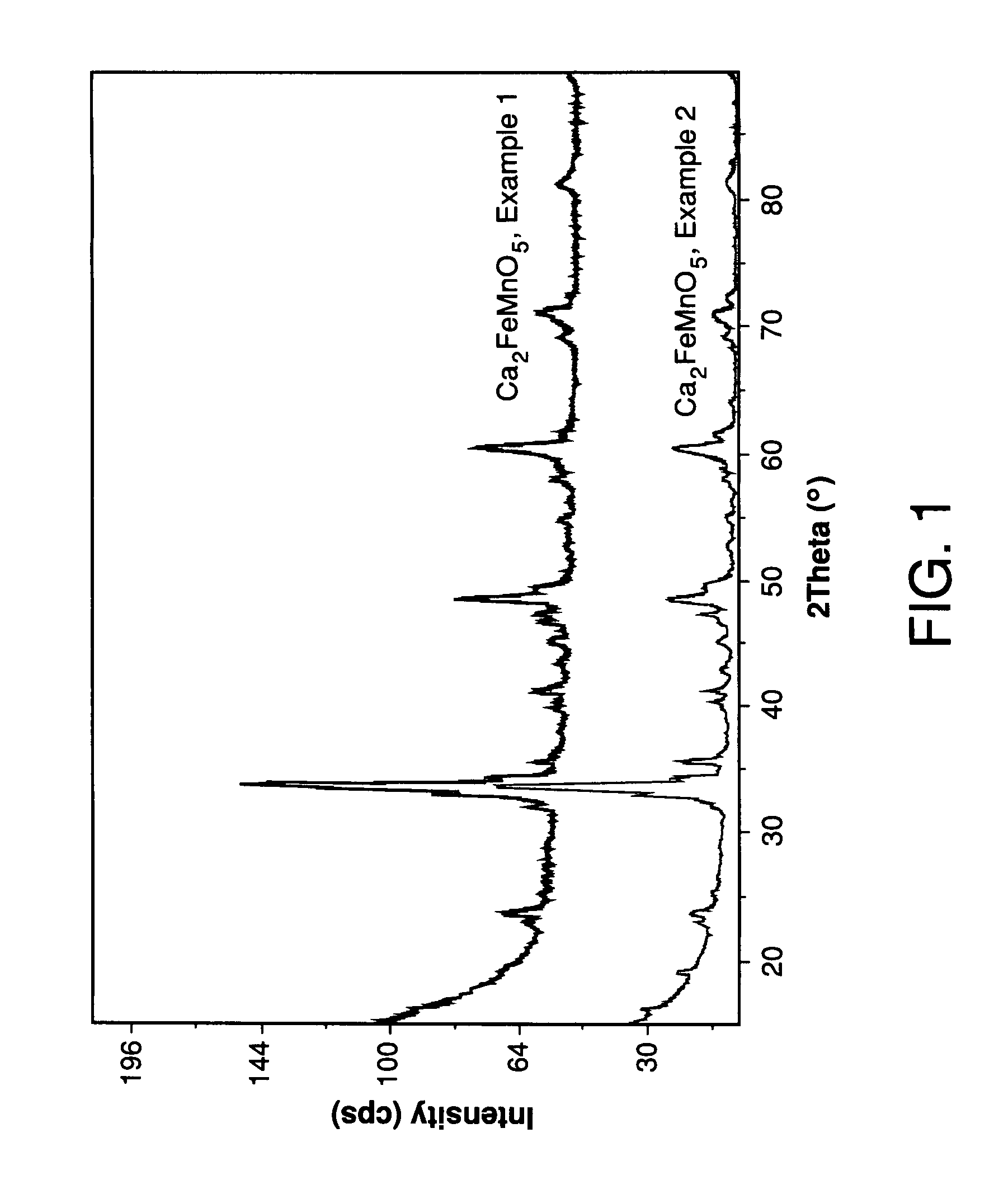Preparation of Complex Metal Oxides
a technology of complex metal oxides and metal oxides, which is applied in the field of complex metal oxide preparation processes, can solve the problems of inefficient process, potential cost, and drawbacks of the process for a large-scale commercial manufacturing of such oxides
- Summary
- Abstract
- Description
- Claims
- Application Information
AI Technical Summary
Benefits of technology
Problems solved by technology
Method used
Image
Examples
control example 1
[0053]The oxide Ca2FeMnO5 was synthesized using the procedure disclosed in U.S. patent application Ser. No. 11 / 165,720.
[0054]An aqueous solution was prepared by dissolving Ca(NO3)2.4H2O, Fe(NO3)3.9H2O, and MnCl2.4H2O in deionized water in a 2 to 1 to 1 molar ratio. The resulting solution volume was 195 mL with a Ca2+ concentration of 0.50 M. A flask containing 1 L of 1.0 M NaHCO3 was heated to 80° C. and stirred vigorously and gaseous CO2 was bubbled continuously into the flask. The Ca—Fe—Mn solution was added dropwise to the NaHCO3 solution resulting in a brownish precipitate. Once the precipitation was complete, the solid was collected by filtration and rinsed repeatedly. Following brief air drying, the solid was added to 1 L of water, stirred briefly, filtered, and rinsed repeatedly. This washing procedure was repeated a second time. The carbonate product was dried in air at 100° C. for 12 hours in an oven. The oxide Ca2FeMnO5 was obtained by calcination of the carbonate at 750° ...
example 2
[0056]The synthesis of Ca2FeMnO5 was accomplished by calcination of a carbonate precursor, nominally Ca2FeMn(CO3)5. The carbonate was prepared by precipitation of soluble salts in aqueous NaHCO3 without the addition of CO2 gas as compared to Control Example 1, as follows.
[0057]An aqueous solution was prepared by dissolving Ca(NO3)2.4H2O, Fe(NO3)3.9H2O, and MnCl2.4H2O in deionized water in a 2 to 1 to 1 molar ratio. The resulting solution volume was 40 mL with a Ca2+ concentration of 0.46 M. A flask containing 300 mL of 1.0 M NaHCO3 was heated to 95° C. and stirred vigorously. The quantity of NaHCO3 corresponded to 7.6 times the stoichiometric amount required for carbonate formation. The Ca—Fe—Mn solution was added dropwise to the NaHCO3 solution in a substantial absence of CO2, resulting in a brownish precipitate. Once the precipitation was complete, the solid carbonate precipitate was collected by filtration and rinsed repeatedly. Following brief air drying, the carbonate precipita...
example 3
[0060]The carbonate precipitate was prepared one more time using the procedure similar to that used in Example 2. The quantity of NaHCO3 used in this example corresponded to 7.9 times the stoichiometric amount required for carbonate formation. In an attempt to remove the Na+ from product, the carbonate precipitate washed 3 times using 1.0 L 95° C. deionized water. Elemental analysis showed that no significant amount of Na+ had been removed from the carbonate precipitate and it contained 0.17 mole Na+ / mole carbonate, as shown above in Table 1. The oxide was obtained by calcination to oxide as in Example 2. XRF analysis was consistent with the intended composition and the presence of 0.23 mole Na+ / mole oxide.
PUM
| Property | Measurement | Unit |
|---|---|---|
| temperature | aaaaa | aaaaa |
| temperature | aaaaa | aaaaa |
| temperature | aaaaa | aaaaa |
Abstract
Description
Claims
Application Information
 Login to View More
Login to View More - R&D
- Intellectual Property
- Life Sciences
- Materials
- Tech Scout
- Unparalleled Data Quality
- Higher Quality Content
- 60% Fewer Hallucinations
Browse by: Latest US Patents, China's latest patents, Technical Efficacy Thesaurus, Application Domain, Technology Topic, Popular Technical Reports.
© 2025 PatSnap. All rights reserved.Legal|Privacy policy|Modern Slavery Act Transparency Statement|Sitemap|About US| Contact US: help@patsnap.com

